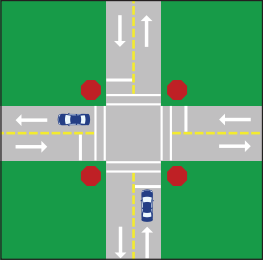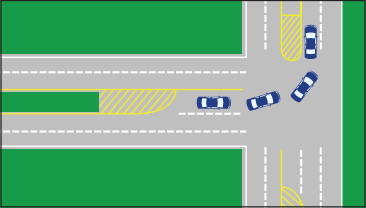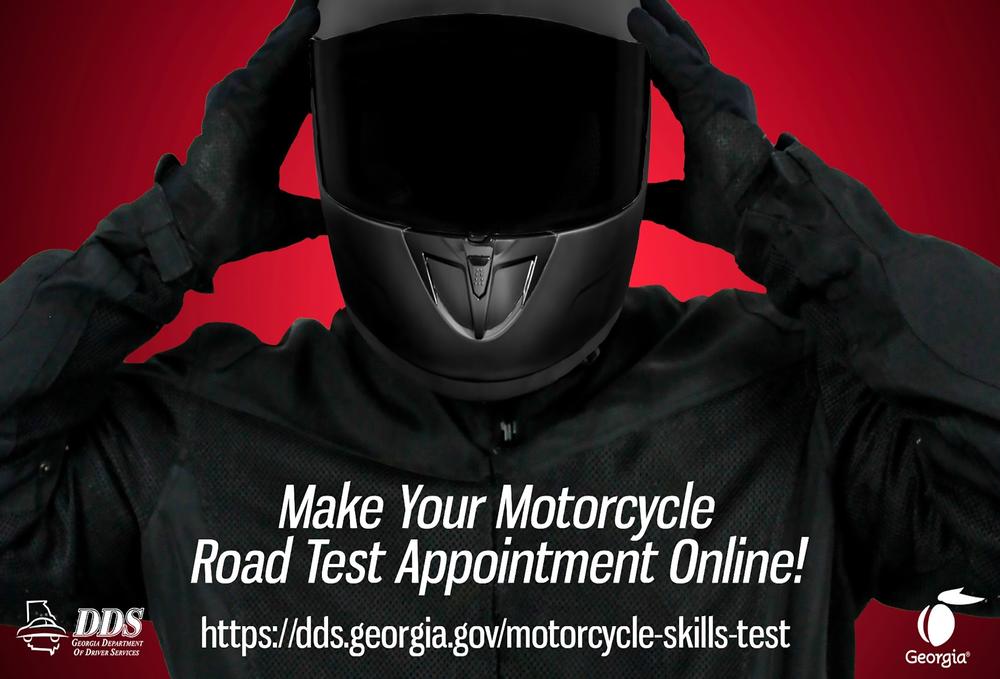
All Locations Closed for New Years Day 2026
All locations are closed Thurs 1 Jan, 2026 for the holiday.
Section 1.5 Continued: Pavement Markings
Pavement Markings
Pavement markings, like highway signs, are used to warn and direct drivers to regulate traffic.
Stop Lines

Stop lines are white lines painted across the pavement at intersections indicating the point beyond which your vehicle should not cross if you are stopping for a traffic control device. In urban areas the line is usually located about four feet before the crosswalk. Drivers must come to a complete stop at the stop line, when present, not at the actual stop sign or traffic signal.
Crosswalk Lines
These white lines are painted across, or partially across the pavement. Sometimes they will be painted in a ladder pattern. When pedestrians are in the crosswalks, they have the right-of-way over motor vehicles. Crosswalks are sometimes in the middle of a block in residential areas, and in some cases, a pedestrian crossing signal is located at the white line.
Railroad Crossings

When a road is crossed by a railroad crossing, the pavement is usually marked with a large X and two R’s. At railroad crossings, a yellow line is always placed on the right side of the center line to prevent passing. The crossing is sometimes equipped with control arms and/or emergency lights, to warn drivers of approaching trains. The driver of the vehicle must stop if warning signals indicate a train is approaching
Center Lines

These are used to separate traffic moving in opposite directions on paved roadways. Broken yellow lines are used when there are only two lanes.
No Passing Lines
Single Lines
These single, solid yellow lines on two-lane roads indicate zones where passing is prohibited. They will be located on the right of the broken yellow line when they apply to the lane in which you are traveling. In some instances, both yellow lines will be solid, indicating it is not safe for passing in either direction.
Double White Lines
These are double white line (dashed or solid) pavement markings on roadways that indicate where vehicles can or cannot cross to access the adjacent lane. When the double white lines are dashed, vehicles are allowed to cross over to the adjacent lane. When the double white lines are solid, lane changes are prohibited.
Edge Lines

These are the solid white lines along the side of the pavement. They serve as safety guides, especially at night when it is difficult to see the edge of the road. A yellow edge line may be used on the left side to warn of narrow or raised medians.
Lane Lines
These are the white dashes that mark the individual lanes of travel on streets and highways having more than one lane for traffic moving in the same direction.
When there are four or more lanes with traffic moving in opposite directions, two solid yellow lines mark the center of the roadway. You may cross these lines only to make a left turn into or from an alley, private road, driveway, or another street. When traveling on a multi-lane road, stay in the right lane except to pass other vehicles traveling in the same direction.
Express Lanes
Express Lanes offer motorists the option to pay a toll to bypass congestion in certain areas on the interstate. All vehicles with no more than two axles or up to six wheels can use Express Lanes if they have a registered Peach Pass. When the vehicle travels through the Express Lane, the toll amount will automatically be deducted from the pre-established account. There are currently two sets of Express Lanes in Georgia.
The I-85 Express Lanes are HOT Lanes along I-85 North in Gwinnett County. They are open 24-hours per day. On the I-85 Express Lanes, registered transit, three or more person carpools, motorcycles, emergency vehicles, and Alternative Fuel Vehicles (AFV) with the proper AFV license plate are allowed to use the lanes toll-free.
The I-75 South Metro Express Lanes are new, reversible lanes along 1-75 South in Henry and Clayton counties. Reversible lanes change directions during the day to provide additional travel options during peak travel periods. When the travel direction is being reversed, signs will show the lanes are closed. On the I-75 South Metro Express Lanes, all vehicles, including motorcycles and electric vehicles, are required to pay a toll. Public transit buses, registered vanpools and emergency response vehicles may use the lanes toll-free if they have a Peach Pass.
Express lanes entrance sign

Express lanes closed sign

Turn Lanes

This lane, bordered by solid yellow and/or broken yellow lines, is in the center of streets and highways to make left turns. A motorist desiring to turn left should proceed to the turn lane just prior to making a left turn. Georgia law prohibits the use of this lane for any purpose other than making a left turn. You may enter this lane no more than 300 feet from the location of the left turn.
When a turning lane is provided for vehicles traveling in both directions, you should use extreme caution before entering the turning lane to make a left turn. There may be a vehicle traveling in the opposite direction also entering the turning lane to make a left turn. This is especially problematic in congested areas.
Bicycle Lanes
These are solid white lines typically located between the farthest right traffic lane and the curb or edge of the roadway. If there is a right-turn-only lane present, the bicycle lane will be located to the left of the right-turn-only lane in order to safely accommodate bicycles traveling straight through the intersection. Bicycle lanes may also be marked with painted symbols of a bicycle. Drivers of motor vehicles are prohibited from driving or parking in the bicycle lane, except to cross over it to make a turn. When crossing over a bicycle lane to make a turn, motorists must yield to bicyclists that are present.
Roundabouts
Roundabouts are sometimes used at intersections instead of stop signs. The purpose of a roundabout is to allow the intersection to handle heavier traffic flow without the need for a signal or a four-way stop. When entering a roundabout, traffic laws concerning right-of-way still apply. You must yield to other traffic that is already in the roundabout. You will always enter a roundabout to the right, and continue circling to the right until you have reached the roadway onto which you want to turn. When reaching the desired road, you will always turn right.
Traffic Striping

These markings, created by diagonal yellow lines, are on streets and highways indicating that the road is narrowing or there is an obstruction on the roadway. The area is similar to a triangle with solid yellow diagonal lines within the outside lines. Always keep to the right of these markings.
